Music Feature: Wagner’s Ring Cycle in HD — The MET at the Mall Goes Global
The bottom line is that Opera in HD is a huge hit all over the United States and is transforming the art form as it succeeds.
Via The Met: Live in HD, New Englanders can experience parts of Wagner’s Ring Cycle without going to New York beginning on October 9 at 1 p.m. with the Met’s new, controversial, and very contemporary production of Das Rheingold, directed by Robert Lepage and conducted by James Levine.
By Helen Epstein.
The Ring’s second installment, Die Walküre, will close the Metropolitan Opera’s “Live in HD” season on May 14, with Deborah Voigt as Brünnhilde and Jonas Kaufmann as Siegmund; Bryn Terfel will once again play Wotan.
The upcoming season of Live in HD features four other new productions: Mussorgsky’s Boris Godunov (October 23); Verdi’s Don Carlo (December 11); John Adams’s Nixon in China (February 12); and Rossini’s Le Comte Ory (April 9).
Maestro Levine will also conduct Donizetti’s comedy Don Pasquale (November 13) and Verdi’s Il Trovatore (April 30).
Last season, you had to get to Burlington’s AMC Theater 3 at least 45 minutes before curtain to avoid the first two neck-craning rows. The audience members are opera fanatics, some of them old-timers who actually attended performances in the pre-Lincoln-Center Met, some of them new to the operatic form since it began its run in America’s local movie theaters.
The members of this Boston-area audience arrive not in taxis but in cars that they park in the ample, outside lot. They’re dressed for comfort not dazzle, with nary a gown or velvet jacket in sight. Instead of perfume wafting through the corridors, there’s the smell of popcorn. Instead of a grand staircase to mount or on which to strike a pose lit by a glittering chandelier, there’s an enormous, cheaply-carpeted lobby lined with movie posters and neon signs for other features. Instead of glamorous designer clothes and stilettos, opera goers wear boots, parkas, and fleece. There are no boxes or loges, not even reserved seats from which to survey the audience. Besides, it’s semi-dark. There’s no bar where you can linger or buy a drink—just the regular concession stand with its sodas, over-sized candy bars, and tubs of popcorn.
Some of the early birds bring a newspaper to read or a book with a tiny, clip-on bed lamp. Others smuggle in their own food and eat an early lunch—whole-grain bread, fresh fruit, nuts, and cheese—out of Tupperware. The program is no thick, glossy brochure but one folded piece of colored paper printed on two sides that lists the names of the conductor, approximate time and duration of the performance, main characters and performers, and a synopsis of the opera. More upscale locales, such as the Mahaiwe Theater in Great Barrington, MA, include a lecture to precede the opera, extending the time frame of a typical performance from three and a half to over four hours.
Tickets are about $20, as compared to the $50-$300 current in most of the world’s opera houses, yet bargain prices alone don’t explain the enormous popularity of the Met HD. The sound is great; the subtitles legible; the camera allows you to see what the Met’s own audience can’t, the conductor’s face, the musicians as they play their solos, the singer’s faces. The bottom line is that Opera in HD is a huge hit all over the United States and is transforming the art form as it succeeds.
======================================================
Reflections on last season’s Opera in HD
 An hour and a half before curtain, opera goers are lining up at the AMC 10 cineplex in Burlington, Massachusetts across the road from the mall. Forty-five minutes later, the only available seats in Theater 3 are in the first two neck-craning rows. It’s 12:15 p.m., a sunny Saturday in February when most New Englanders are outside, but like several million people in over 40 countries around the world they have assembled for The Met: Live in HD.
An hour and a half before curtain, opera goers are lining up at the AMC 10 cineplex in Burlington, Massachusetts across the road from the mall. Forty-five minutes later, the only available seats in Theater 3 are in the first two neck-craning rows. It’s 12:15 p.m., a sunny Saturday in February when most New Englanders are outside, but like several million people in over 40 countries around the world they have assembled for The Met: Live in HD.
Unlike the audience actually at the Metropolitan Opera (the Met), they’re dressed for comfort not display, in sweaters, parkas, insulated boots, and layers of fleece. Instead of crossing Lincoln Center plaza, they’ve crossed an enormous parking lot. Instead of a grand staircase and glittering chandeliers, there’s an industrially carpeted lobby lined with posters and neon signs. The smell of popcorn rather than perfume wafts through the air, and inside the dim theater there are no ushers, no plush boxes or loge of the kind that Flaubert and Wharton described and that the Impressionists painted—not even reserved seats.
It’s too dimly lit to see much of anything and some of the early birds have brought small flashlights with which to read their newspapers or clipped tiny bed lamps to their books. Others are eating a smuggled-in lunch—whole-grain bread, fresh fruit, nuts and cheese—out of Tupperware. Some are examining the program—no thick, glossy brochure but a poorly-designed handout printed on two sides that lists the conductor’s name, approximate time and duration of the performance, main characters and performers, and a synopsis of the opera.
More upscale locales, such as the Mahaiwe Theater in Great Barrington, MA, hire a lecturer to introduce the opera, which extends the time frame of a typical performance from three and a half to four and a half hours.
It’s light enough to see that, at 62, I’m on the younger side of this very straight, suburban crowd. They appreciate the schedule: live Saturday telecasts at 1 p.m.; Encores at 6 p.m. on Wednesdays, though driving on the edge of rush hour can sometimes be a problem. They like the intimacy of the space (250 seats instead of the Met’s 3,800) and the ticket price ($20, as compared to the $30-$300 plus hotel room, meals, and parking they’d have to spend if they drove to New York). Yet the price alone doesn’t explain the enormous popularity of The Met: Live in HD.
Last week’s Simon Boccanegra was packed, people were saying, because the sympathetic and internationally famous 69-year-old tenor Placido Domingo was making his debut as a baritone, and local idol, the Boston Symphony Orchestra’s artistic director James Levine, was conducting. The week before, Carmen was packed because, well, it’s one of the most accessible operas in the canon and had the young, beautiful, vocally perfect, Latvian mezzo Elina Garanca to sing the title role.
Next month’s Hamlet (by the little known, French composer Ambroise Thomas) is already sold out, they say, because everybody knows the story and Ophelia will be Nathalie Dessay, who’s as gifted an actress as a singer. But the bottom line is that Met: Live in HD is a huge hit at movie houses all over the United States and is transforming the art form as it succeeds.
“This is NOT opera,” say the purists, echoing Walter Benjamin’s famous 1936 essay “The Work of Art in the Age of Mechanical Reproduction,” and in one sense they are right. No amount of Dolby Surround Sound can replicate the experience of hearing an orchestra and singers live. Nothing can replicate viewing the operatic spectacle in its entirety—audience, orchestra, curtain, stage, performers—as well as the architecture of the house, its location in the city, and its place within cultural tradition and the social hierarchy.”
“Mechanical reproduction separates art from its basis in cult,” wrote Benjamin. “Even the most perfect reproduction of a work of art is lacking in one element: its presence in time and space, its unique existence at the place where it happens to be.”

The Metropolitian Opera in New York: It is easier and cheaper to see the productions in your local mall.
My musician friend Susan Miron used to drive from Newton to Framingham to see The Met: Live in HD but stopped because she missed what Benjamin called the “aura” of the authentic.
“I’m a huge opera snob,” she says. “I love driving down to New York, the anticipation, getting dressed, standing in line, the smells of perfume. You look at what other people are wearing. The fabrics, the gowns. There’s a sense of occasion. That evening may turn out to be one of the highlights of your life, something you’ll remember until you die. It’s like going to a palace. You drink from the Ezio Pinza fountain. You get to have your own subtitles on your own little screen. There are people from all over the world: India, Oklahoma, the old ladies, the gay guys in velvet. Even the seats are beautiful. It’s a rite; a grand experience. I can’t stand the smell of popcorn at the movies. I feel like I’m slumming.”
Not me. I’ve become a fan of the Met at the mall. Like some of my Lexington neighbors, I’m an unreconstructed New Yorker who went to the Met and listened to its Saturday afternoon radio broadcasts as I grew up. Although I liked using my mother’s opera glasses, I never found looking through them a pleasurable way of following the action —miles away, it seemed—onstage.
When subtitles were introduced, I was glad to have a translation but uncomfortable shifting my gaze between text and the stage. The Met’s hi-tech telecasts put text and image onscreen in a way that’s easy on the eye; in their integration of literature, music, dance, and the visual arts, they provide a more cohesive form of gesamtkunstwerk (the total work of art) than what Wagner imagined and a different but in some ways superior experience of opera than I’ve experienced (even up close) in person.
The Met has been broadcasting for 77 years over the radio. Cinematographers have been filming operas for about as long, both in Europe and in the United States. Joseph Losey’s Don Giovanni (1979, shot in the palaces and on the canals of Venice) and Zefferelli’s lavish La Traviata (1983) are two of my favorites. The practice of broadcasting operas and plays live began with the birth of television and PBS has accustomed us to telecasts from around the world. Digital technology, bolstered by the money and power of the Met, dwarfs them all in creating what is, in effect, a new form that draws on the techniques of narrative film, documentary, and TV journalism.
Some of Benjamin’s arguments have become obsolete. No longer is it impossible “to assign to a spectator a viewpoint which would exclude from the actual scene such extraneous accessories as camera equipment, lighting machinery, staff assistants, etc.—unless his eye were on a line parallel with the lens . . . (rendering) superficial and insignificant any possible similarity between a scene in the studio and one on the stage.”
The Met: Live in HD utilizes 10 cameras, many cameramen behind many different lenses, and the visual gains for the opera goer are huge. Not only are we drawn intimately into the action onstage, but we can see what the Met audience cannot: we see the conductor as the singers and musicians see him; we see individual musicians and their instruments when their solos occur; the action onstage seems to be happening at a distance of a few feet, and we can follow the protagonists into the wings and backstage.
This is most obvious as the cameras zoom in for close-ups. “Fifty years ago,” Benjamin wrote in 1936, “a slip of the tongue passed more or less unnoticed. Only exceptionally may such a slip have revealed dimensions of depth in a conversation which had seemed to be taking its course on the surface. Since the Psychopathology of Everyday Life things have changed. This book isolated and made analyzable things which had heretofore floated along unnoticed in the broad stream of perception.” Similarly, he argues, photographic processes make available aspects of the original “that are unattainable to the naked eye yet accessible to the lens.”
Opera goers who have used opera glasses for years tend to focus on the facial expressions of performers and their small gestures that get lost beyond the first few rows of the orchestra. But The Met: Live in HD broadcasts reveal so much more than that: we can appreciate the intricate patterns of costumes as though we were standing before an oil portrait in a museum; we can see the details of significant operatic props such as daggers and vials of poison as though we were in a small room; we can almost feel the dankness of a dungeon wall or the freshness of a leafy garden.
“The camera that presents the performance,” Benjamin wrote, “need not respect the performance as an integral whole.” True, but here the cameras enhance a form that’s often visually boring and, at other times, hopelessly muddled. Even the convoluted story of Simon Boccanegra made sense in the movie. “He knows where the bodies are buried,” I overheard someone whispering in the dark, “Get it?”

The telecasts reward the photogenic performers who can act and sing, such as Latvian mezzo-soprano Elina Garanca
The new telecasts privilege the visual and will affect opera performance accordingly. They are unkind to old-fashioned directors, set designers, and performers. Stock stances, gestures, and choreography look obsolete. Singers who are too old for their roles or too fat or short or unattractive are out of luck. The camera is unforgiving of wobbly double chins and flabby bellies.
The Hollywood ceiling on age for star women performers looms ahead —maybe for men too. Younger, more versatile singers who can act as well as dance like Elina Garanca and Nathalie Dessay stand to benefit the most in this new operatic world. So do singers and directors who are witty and whose accents don’t preclude making themselves understood when interviewed between the acts.
Renee Fleming does well as an articulate, elegant, and photogenic interview as well as interviewer; Placido Domingo is always nice to look at but at times barely intelligible. It’s unfair to singers with great voices who don’t meet the new standards, but it seems to be the future.
“In New York, there’s electricity,” said the woman sitting next to me, “but here I’m more involved. I know it’s not the real thing, but it’s a more intimate alternative.”
Will these telecasts create a new, younger audience that doesn’t already love opera? The Met: Live in HD has a program for distribution to schools, but the jury’s still out on that and a host of other questions. Does a Met broadcast affect a live, local production of the same opera? Will the opera movies spur attendance for local opera companies? Have the Met’s own appeals for donations during the broadcasts had results? Will the current movie audiences grow?
Next month, it’s Ambroise Thomas’ Hamlet at the mall. You probably haven’t seen or heard it. I’m planning to go.
===============================
Helen Epstein is the author of Music Talks in paper and on Kindle.
Tagged: Culture Vulture, Das Rheingold, Die Walküre, Metropolitan Opera, Ring Cycle, Robert Lepage


